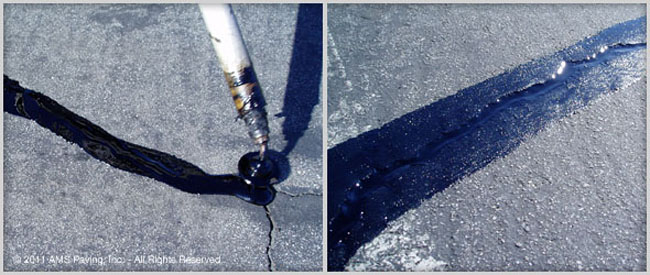

There are several ways to deal with cracks; the method of dealing with them depends on their size and depth. Large cracks of 1" or greater, should be filled with Hot Asphalt Mix. In these cases, the cracks will be blown out and cleaned of debris, then filled with fine mix asphalt (asphalt with little or no rocks). The asphalt in the cracks will then be compacted using a vibratory plate.
Cracks of 1" or less will typically be filled with Hot Rubberized Crack Fill or Cold Pour. Hot rubberized crack fill involves blowing out the cracks with compressed air and filling them with a hot, rubberized fill material. Following this procedure, the asphalt will typically be slurry sealed. However, crack fill is not a final solution to the problem of cracking; it is realistically a temporary fix for a more complex problem. The natural expansion and contraction of the asphalt itself will often tend to squeeze the mixture up and out of the crack or, in the case of contraction, will cause the material to sink deeper in the crack. Additionally, in areas of extreme temperatures or in areas of very porous soil, the high temperatures can actually cause the material to melt and dissipate into the soil beneath.
Cold Pour is often used instead of hot rubberized crack fill. The applications are similar to the hot process. The advantage of the hot mixed process is better adherence to the existing asphalt and usually a longer lasting product. Cold Pour consists basically of a substance that is nothing more than a thickened version of the same material used in Slurry Seal.
It is common to use one of the above processes prior to the application of Slurry sealing the asphalt.
